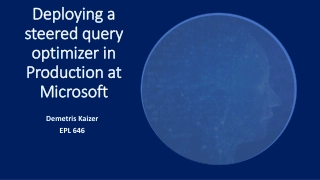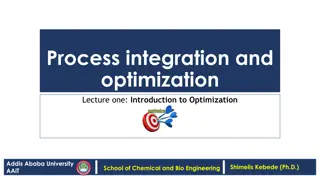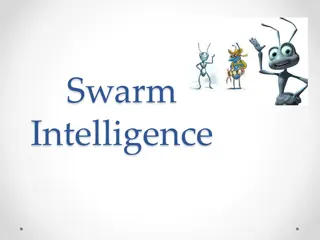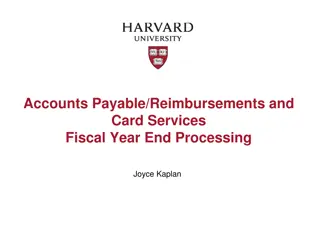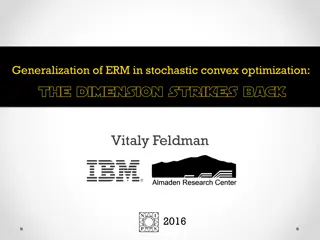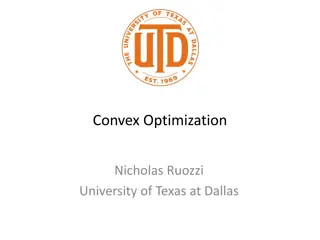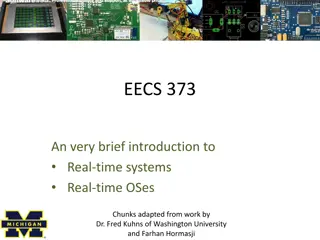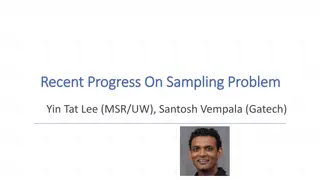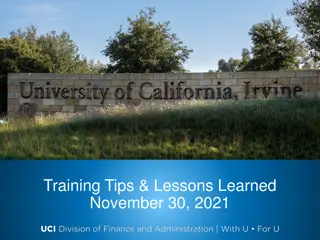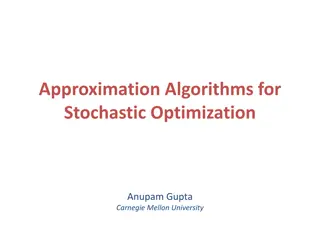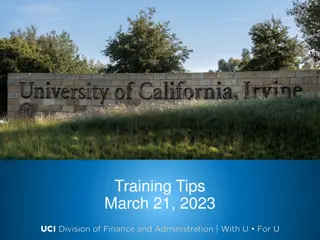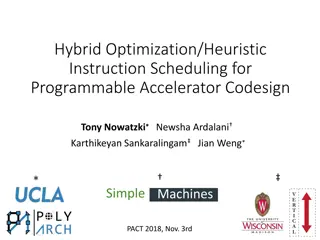Important Deadlines for Optimization Class
"Upcoming deadlines for the Optimization class include P2 - Optimization due on 2/23 at 10pm, HW4 covering LP and IP due on 2/14 at 10pm (Happy Valentine's Day). Exam 1 will be on 2/16."
Download Presentation

Please find below an Image/Link to download the presentation.
The content on the website is provided AS IS for your information and personal use only. It may not be sold, licensed, or shared on other websites without obtaining consent from the author.If you encounter any issues during the download, it is possible that the publisher has removed the file from their server.
You are allowed to download the files provided on this website for personal or commercial use, subject to the condition that they are used lawfully. All files are the property of their respective owners.
The content on the website is provided AS IS for your information and personal use only. It may not be sold, licensed, or shared on other websites without obtaining consent from the author.
E N D
Presentation Transcript
Announcements Assignments: P2: Optimization Due Thurs 2/23, 10pm HW4 (online) Covers LP, IP Due Tues 2/14, 10 pm (Happy Valentine s Day) EXAM 1 2/16!!
Plan Last Time Linear programming formulation Problem description Graphical representation Optimization representation Today Solving linear programs Higher dimensions than just 2 Integer programs
Poll 4 (already completed) What is the relationship between the half plane: ?1?1+ ?2?2 ?1 and the vector: ? ?1,?2 ?2 Infeasible II I Feasible III IV ?1
Question ? and initial point ?(0), Given the cost vector ?1,?2 Which unit vector step ?will cause ?(1)= ?(0)+ ? to have the lowest cost ???(1)? II I ? III IV Notation Alert!
Cost Contours ? where will Given the cost vector ?1,?2 ??? = 0 ? ??? = 1 ? ??? = 2 ? ??? = -1 ? ??? = -2 ?
Question As the magnitude of ? increases, the distance between the contours lines of the objective ???: A) Increases B) Decreases
AI: Representation and Problem Solving Integer Programming Instructor: Stephanie Rosenthal Slide credits: CMU AI with drawings from http://ai.berkeley.edu
Solving a Linear Program Inequality form, with no constraints ??? min ?.
Solving a Linear Program Inequality form, with one constraint ??? min ?. s.t. ?1?1+ ?2?2 ?
Poll 1 True or False: A minimizing LP with exactly one constraint, will always have a minimum objective at . ??? min ?. s.t. ?1?1+ ?2?2 ?
Question True or False: A minimizing LP with exactly two constraints, will always have a minimum objective > . ??? min ?. s.t. ?11?1+ ?12?2 ?1 ?21?1+ ?22?2 ?2
Convexity Convex sets are those in which you can draw a line between two points and all the points between them are also in the set Convex optimization problems are ones in which the local minimum is also the global minimum Convex functions have the property that for any point between two points x and y in a convex set: ? ?? + 1 ? ? ?? ? + 1 ? ? ? Linear functions (like our costs) are convex!
Convexity and LPs LPs are constrained convex problems. The constraints form a convex set The objective function is convex What does this tell us about the costs at the corners of a constrained polygon?
Bigger Picture Constrained Integer programming Linear programming Deep learning Unconstrained Most machine learning Convex Nonconvex
Convexity and LP Solutions Solutions are at feasible intersections of constraint boundaries!!
Solving an LP Solutions are at feasible intersections of constraint boundaries!! Algorithm Check objective at all feasible intersections In more detail: 1. Enumerate all intersections 2. Keep only those that are feasible (satisfy all inequalities) 3. Return feasible intersection with the lowest objective value
Solving an LP But, how do we find the intersection between boundaries? 100 100 Calorie min Calorie max Sugar Calcium 2000 2500 100 700 50 50 4 70 ??? min ? s.t. ?? ? ? = ? = 3 20
Solving an LP Solutions are at feasible intersections of constraint boundaries!! Algorithms Check objective at all feasible intersections Simplex
Solving an LP Simplex algorithm Start at a feasible intersection (if not trivial, can solve another LP to find one) Define successors as neighbors of current intersection i.e., remove one row from our square subset of A, and add another row not in the subset; then check feasibility Move to any successor with lower objective than current intersection If no such successors, we are done Greedy local hill-climbing search! but always finds optimal solution
Solving an LP Solutions are at feasible intersections of constraint boundaries!! Algorithms Check objective at all feasible intersections Simplex Interior Point Figure 11.2 from Boyd and Vandenberghe, Convex Optimization
What about higher dimensions? Problem Description Graphical Representation Optimization Representation ??? min ? s.t. ?? ?
Marty, youre not thinking fourth-dimensionally https://www.youtube.com/watch?v=CUcNM7OsdsY
Shapes in higher dimensions How do these linear shapes extend to 3-D, N-D? ?1 ?1+ ?2 ?2= ?1 ?1 ?1+ ?2 ?2 ?1 ?1,1 ?1+ ?1,2 ?2 ?1 ?2,1 ?1+ ?2,2 ?2 ?2 ?3,1 ?1+ ?3,2 ?2 ?3 ?4,1 ?1+ ?4,2 ?2 ?4
What are intersections in higher dimensions? How do these linear shapes extend to 3-D, N-D? Calorie min Calorie max Sugar Calcium 2000 2500 100 700 100 100 3 20 50 50 4 70 ??? min ? s.t. ?? ? ? = ? =
How do we find intersections in higher dimensions? Still looking at subsets of ? matrix Calorie min Calorie max Sugar Calcium 2000 2500 100 700 100 100 3 20 50 50 4 70 ??? min ? s.t. ?? ? ? = ? =
Linear Programming We are trying to stay healthy by finding the optimal food to purchase. We can choose the amount of stir-fry (ounce) and boba (fluid ounces). Healthy Squad Goals 2000 Calories 2500 Sugar 100 g Calcium 700 mg Food Cost Calories Sugar Calcium Stir-fry (per oz) 1 100 3 20 Boba (per fl oz) 0.5 50 4 70 What is the cheapest way to stay healthy with this menu? How much stir-fry (ounce) and boba (fluid ounces) should we buy?
Linear Programming Integer Programming We are trying healthy by finding the optimal amount of food to purchase. We can choose the amount of stir-fry (bowls) and boba (glasses). Healthy Squad Goals 2000 Calories 2500 Sugar 100 g Calcium 700 mg Food Cost Calories Sugar Calcium Stir-fry (per bowl) 1 100 3 20 Boba (per glass) 0.5 50 4 70 What is the cheapest way to stay healthy with this menu? How much stir-fry (ounce) and boba (fluid ounces) should we buy?
Linear Programming vs Integer Programming Linear objective with linear constraints, but now with additional constraint that all values in ? must be integers ??? ??? min ?. s.t. ?? ? min ?. s.t. ?? ? ? ? We could also do: Even more constrained: Binary Integer Programming A hybrid: Mixed Integer Linear Programming Notation Alert!
Integer Programming: Graphical Representation Just add a grid of integer points onto our LP representation ??? min ?. s.t. ?? ? ? ?
Integer Programming: Scheduling How would we formulate our CSP as an integer program? Home - Jared L. Cohon University Center - Student Affairs - Carnegie Mellon University How would we could we solve it?
Convexity and IPs Integer programs are not convex, but perhaps we can use the LP solvers to find solutions to integer programs? Relax IP to LP by dropping integer constraints ??? Remember heuristics? min ?. s.t. ?? ? ? ?
Poll 2: True/False: It is sufficient to consider the integer points around the corresponding LP solution?
Poll 3: be the optimal objective of an integer program ?. be an optimal point of an integer program ?. be the optimal objective of the LP-relaxed version of ?. be an optimal point of the LP-relaxed version of ?. Let ??? Let ??? Let ??? Let ??? Assume that ? is a minimization problem. = min ??? ??? s.t. ?. Which of the following are true? Select all that apply. A) ??? B) ??? C) ??? ?? ? ? ? = ??? ??? ??? = min ??? ??? s.t. ?. ?? ?
Solving an IP Branch and Bound algorithm 1. Push LP solution of problem into priority queue, ordered by objective value of LP solution 2. Repeat: If queue is empty, return IP is infeasible Pop candidate solution ??? If ??? Otherwise, select a coordinate ?? that is not integer valued, and add two additional LPs to the priority queue: Left branch: Added constraint ?? ????? ?? Right branch: Added constraint ?? ???? ?? Note: Only add LPs to the queue if they are feasible from priority queue is all integer valued, we are done; return solution
Branch and Bound Example ? = 17.5,5 ? = 20.5 ?1 18 ?1 17 ? = 1,0.6? Priority Queue: 1. ? = 17.5,5 , ? = 20.5
Branch and Bound Example 15 10 ?1 17 ?1 18 5 10 15 20 25 15 15 10 10 5 5 10 15 20 25 10 15 20 25
Branch and Bound Example ? = 17.5,5 ? = 20.5 ?1 18 ?1 17 ? = 17,6 ? = 20.6 ? = 18,4.85 ? = 20.91 ? = 1,0.6? Priority Queue: 1. ? = 17,6 , 2. ? = 18,4.85 , ? = 20.91 ? = 20.6
Activity + Poll Constraints : ? = 1.4? + 4.58 ? = 1.56? + 3.41 ? = 1.9? + 12.16 ? = .44? + 4.21 (3.4,5.7) (.2,4.3) (4.5,3.61) Priority Queue: y Poll 4: What is the LP solution? Poll 5: What is the IP solution? (2.7,0.8) C =[-1,-3] x
Activity Constraints : ? = 1.4? + 4.58 ? = 1.56? + 3.41 ? = 1.9? + 12.16 ? = .44? + 4.21 (3.4,5.7) (.2,4.3) (4.5,3.61) Priority Queue: -20.5: (3.4,5.7) y (2.7,0.8) C =[-1,-3] x
Activity Constraints : ? = 1.4? + 4.58 ? = 1.56? + 3.41 ? = 1.9? + 12.16 ? = .44? + 4.21 (3.4,5.7) (.2,4.3) (4.5,3.61) Priority Queue: -20.5: (3.4,5.7) -19.6: (3,5.53) (x <= 3) -17.7: (4,4.56) (x >=4) y (2.7,0.8) C =[-1,-3] x
Activity Constraints : ? = 1.4? + 4.58 ? = 1.56? + 3.41 ? = 1.9? + 12.16 ? = .44? + 4.21 (3.4,5.7) (.2,4.3) (4.5,3.61) Priority Queue: -20.5: (3.4,5.7) -19.6: (3,5.53) (x <= 3) -17.7: (4,4.56) (x >=4) -18.0: (3,5) (x<=3,y<=5) Inf: (x<=3,y>=6) y (2.7,0.8) C =[-1,-3] Why do we not need to recurse on -17.7? x


